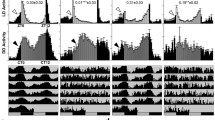Abstract.
Mechanisms underlying circadian clock function in Drosophila melanogaster have been revealed by genetic and molecular approaches. Two interlocked transcriptional feedback loops involving at least the period, timeless, Clock, and cycle genes generate molecular oscillations that are believed to control behavioral rhythmicity and other clock outputs. These oscillations are further enhanced and fine-tuned to match the duration of the solar day by post-transcriptional and post-translational mechanisms depending on the PERIOD and TIMELESS proteins and on the protein kinases DOUBLE-TIME and SHAGGY. Light is the principal zeitgeber for synchronizing molecular and behavioral rhythmicity via the blue-light photoreceptor CRYPTOCHROME and the TIMELESS protein. In addition, light seems required for maintaining robust molecular oscillations at least in peripheral clock-gene-expressing tissues like the eyes, antennae, or Malpighian tubules. Relaying temporal information to cells and tissues expressing overt biological rhythms involves regulation of "output genes" at multiple levels. Although their regulation depends on the major clock genes, the majority of the clock-controlled genes are not direct targets of clock factors.
Similar content being viewed by others
Author information
Authors and Affiliations
Additional information
Electronic Publication
Rights and permissions
About this article
Cite this article
Stanewsky, R. Clock mechanisms in Drosophila . Cell Tissue Res 309, 11–26 (2002). https://doi.org/10.1007/s00441-002-0569-0
Received:
Accepted:
Published:
Issue Date:
DOI: https://doi.org/10.1007/s00441-002-0569-0




